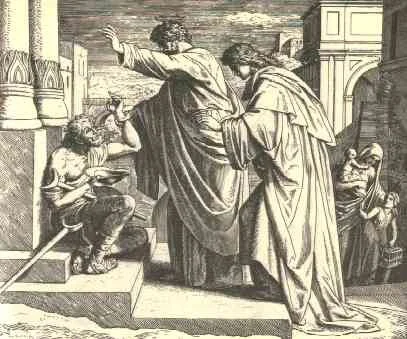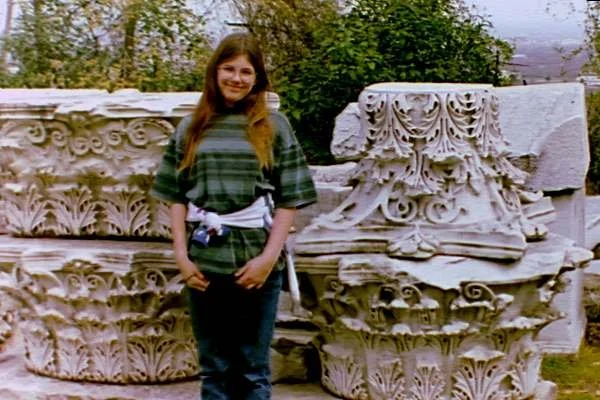Chapter Three and Four Outline:
I. Witness in Jerusalem (Acts 1-7)
<A-F in Chapters One and Two>
G. An Astounding Healing (3:1-11)
H. Assembly at theTemple(3:12-26)
I. Anxious Leaders ofJudea(4:1-22)
J. Awesome Prayer and Power (4:23-37)
Summary:
The new “Messianics” were becoming known in Jerusalem, and began to care for one another. One afternoon at the gate of the Temple, Peter and John healed a crippled beggar who was asking for help. This caused quite a stir, as the people recognized him from the many times they passed by him and now saw that he could walk. They gathered around Peter and he explained that the power that healed the man was the power of the risen Messiah! He told the people they were guilty of killing Jesus, but that they could be forgiven of their sins by repenting and turning to the Lord. Peter and John were swiftly arrested and brought before the Jewish religious authorities who questioned them about the healing. They could find no wrongdoing by Peter and John and could not deny the healing of the crippled man, but they wished them to cease causing a stir among the people. They threatened the two and sent them on their way, recognizing the numbers of Messianic followers of Jesus were swelling to about five thousand!
Commentary: Chapter Three
w3:1 “ninth hour”: refers to the time of the afternoon sacrifice. It should be translated “ninth hour of daylight”, or about 3 PM.
w3:1 “Temple”: The temple expansion of Herod the Great began in 19 BCE and was completed in 62 CE (long after the end of Herod’s death) only a few years before it was destroyed by the Romans in 70 CE. Herod’s temple is called the “Second Temple” and was a redesign of the Zerubbabel temple of the return from Babylonian exile. In many respects similar to Solomon’s Temple (referred to as the First Temple). The inside of Herod’s temple was lavishly decorated with Cedar paneling, carved with flowers, palm-trees and cherubim, covered with gold. At the entrance to the temple, similar to Solomon’s Temple, stood the Altar for animal sacrifice, as well as the Laver. As with Solomon’s Temple the priests entered through a large porch and into the main room, called the ‘Holy Place’. In the Holy Place stood five pairs of Lamp-stands, the Table of Showbread and the Incense Altar. The adjoining inner room was called the ‘Holy of Holies’ and was approached from the Holy Place. In the “Most Holy Place” stood the Ark of the Covenant.
With this magnificent project Herod wanted to impress the Roman world, and also wanted to win the favor of his subjects. Although built on the same plan as Solomon’s temple, it was twice as high and much more impressive, with a lot of gold being used to add to its splendor. Probably the most impressive feature was the great temple platform on which it was built, still in existence to this day. The area of this platform measures approximately 35 acres. Covered cloisters ran right around the outer courtyards of Herod’s temple, with the main entrances from the south. This entrance led to the “Court of the Gentiles”. Notices along a dividing wall called the “Soreg” were placed in Greek and Latin and clearly warned Gentiles not to enter the inner courts of the Temple. The “Heckal” or building of the Temple proper, set inside the courts. Lined with gold along its top, the building was of magnificent construction.
w3:2 “Beautiful gate”: may be the gate access to the Women’s court, since that court is where money offerings of silver and gold were made. That would be a likely place for a beggar to sit. Some scholars note the possibility of the Nicanor gate as the site, but this seems less likely. The Nicanor Gate divided the Women’s court from the inner altar of the Temple, but the access was also used as the place of the Levitical choir.
w3:2-12 “lame”: Since this man had been crippled from birth, he may have never entered the inner courts of the Temple. Under Levitical law (see Lev. 21:16-23) only a priest was not able to enter the Temple with physical deformity. Some scholars note, however, that the rabbinic court appeared to limit access to others who were deformed in the Second Temple (inside the Heckal or Temple Building proper). It was possible that he used this vantage point at the gate of the Temple as a means to ask for money, as people knew he could never go in unless he was healed and would feel sympathetic towards him. He asked Peter and John for money as they approached the Temple. “Then Peter said, Silver and gold have I none; but such as I have give I thee: In the name of Jesus Christ of Nazareth rise up and walk.” (Acts 3:6). He was no doubt excited not only about being healed, but for the first time he could enter the Temple to worship God!
w3:22 “a prophet”: Some rabbinic scholars projected the coming of two individuals – the Messiah of Israel, and the Great Prophet to Israel (a possible reference to this may be found in Jn. 1:20ff). Peter argues the two are one: Jesus of Nazareth.
Commentary: Chapter Four
w4:1 “Sadducees”: (also Matt. 3:7; 16:1,6,11,12; 22:23,34; Mark 12:18; Luke 20:27; Acts 5:17; 23:6,7,8). This Jewish religious sect is only mentioned in the New Testament. Scholars believe it was formed between the return of the Jews from captivity (536 BCE) and 200 BCE. Evidence regarding them prior to the Babylonian exile has not been discovered anywhere in Israel. It is thought their name possibly originated from the high priest Zadok during David’s reign (2 Sam. 8:17; 15:24-29) or from another Levite named Zadok, whose ancestors the Lord said would serve at the altar in the new temple (Ezek. 40:46; 44:15). Others, suggest that the term “Sadducees” comes from a Zadok who was a follower of Antigonus of Socho (c. 250 BCE).
Josephus said the upper classes liked the Sadducees, especially the wealthy (Antiq. xiii. 10,6). Sadducees frequently disagreed with the Pharisees though they were sometimes obligated to work along side them (Acts 23:6; Antiq. xviii. 1,4). According to Josephus, the Sadducees felt that only the Word of God itself could be used as authoritative standard, while the Pharisees stood also on the teachings and oral traditions of their forefathers (Antiq. xiii. 10,6). The Sadducees did not believe in an afterlife (Matthew 22:23; Acts 23:8; Antiq. xviii. 1,4), or in the existence of spirits or angles (Acts 23:8), which seems odd given the fact of their strong Scriptural base. They might have taken this stance only to oppose the Pharisees (ibid.). Their other stance, which denied the idea of “fate”, allowed them to feel circumstances came from man’s own actions, whether good or bad (Antiq. xiii. 5,9; see also Jewish War, II.8,14). It seems the same two Sadducees of the household of Hanan (Annas and Caiaphas), acted against Jesus and the early Messianic followers (John 11:45-53; 18:13, 19-24; Acts 5:17-41).
w4:25 “mouth of David”: a quote of Ps. 2:1-2.
w4:32 “all thing in common”: The needs arose because many were away from home. At some later point the Temple stopped supplying needs for believers in Jesus (see Acts 6) and the need to establish more organized funds became important. There is no command that all believers should live as a commune. It is also noteworthy that the Jerusalem fellowship always characteristically lacked funds! Remember, the Book of Acts is a narrative, not an instruction. The point is NOT to get this methodology for church decision-making, it is a simple record of what they did. Some Scriptures are simple narratives (like Gideon and his fleece – cp. Judges 6-8). In such cases, one can appreciate the story without feeling the need to imitate it. See also Acts 2:44.


